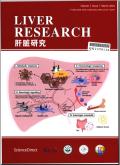Single-cell and machine learning approaches uncover intrinsic immune-evasion genes in the prognosis of hepatocellular carcinoma
IF 2.1
Q2 Medicine
引用次数: 0
Abstract
Background and aims
Hepatocellular carcinoma (HCC) is a tumor of high heterogeneity and complexity, which poses significant challenges to effective treatment and patient prognosis because of its immune evasion characteristics. To address these issues, single-cell technology and machine learning methods have emerged as a promising approach to identify genes associated with immune escape in HCC. This study aimed to develop a prognostic risk score model for HCC by identifying intrinsic immune-evasion genes (IIEGs) through single-cell technology and machine learning, providing insights into immune infiltration, enhancing predictive accuracy, and facilitating the development of more effective treatment strategies.
Materials and methods
The study utilized data from The Cancer Genome Atlas database to analyze gene expression profiles and clinical data related to intrinsic immune evasion in patients with HCC. Various tools, including the Human Protein Atlas, cBioPortal, single-cell analysis, machine learning, and Kaplan-Meier plot, were used to analyze IIEGs. Functional enrichment analysis was conducted to explore potential mechanisms. In addition, the abundance of infiltrating cells in the tumor microenvironment was investigated using single-sample gene set enrichment analysis, CIBERSORT, xCELL, and tumor immunophenotype algorithms. The expression of glycosylphosphatidylinositol anchor attachment 1 (GPAA1) was examined in the clinical sample of HCC by quantitative real-time polymerase chain reaction, Western blotting, and immunohistochemical staining.
Results
Univariate Cox analysis identified 63 IIEGs associated with the prognosis of HCC. Using random forest, least absolute shrinkage and selection operator regression analysis, and support vector machine, a risk score model consisting of six IIEGs (carbamoyl-phosphate synthetase 2, aspartate transcarbamylase, and dihydroorotase (CAD), phosphatidylinositol glycan anchor biosynthesis class U (PIGU), endoplasmic reticulum membrane protein complex subunit 3 (EMC3), centrosomal protein 55 (CEP55), autophagy-related 10 (ATG10), and GPAA1) developed, which was validated using 10 pairs of HCC and adjacent non-cancerous samples. Based on the calculated median risk score, HCC samples were categorized into high- and low-risk groups. The Kaplan-Meier curve analysis showed that the high-risk group had a worse prognosis compared with the low-risk group. Time-dependent receiver operating characteristic analysis demonstrated the accurate predictive capability of the risk score model for HCC prognosis. Furthermore, immune infiltration analysis showed a positive correlation between the risk score model and 40 immune checkpoint genes as well as Th2 cells.
Conclusions
A prognostic risk score model was formulated by six IIEG signatures and showed promise in predicting the prognosis of patients diagnosed with HCC. The utilization of the IIEG risk score as a novel prognostic index, together with its significance as a valuable biomarker for immunotherapy in HCC, provides benefit for patients with HCC in determining therapeutic strategies for clinical application.
单细胞和机器学习方法揭示了肝细胞癌预后中的内在免疫逃避基因
背景与目的肝细胞癌(HCC)是一种高度异质性和复杂性的肿瘤,由于其免疫逃避特性,对有效治疗和患者预后提出了重大挑战。为了解决这些问题,单细胞技术和机器学习方法已经成为一种有前途的方法来识别HCC中与免疫逃逸相关的基因。本研究旨在通过单细胞技术和机器学习技术鉴定固有免疫逃避基因(IIEGs),建立HCC的预后风险评分模型,为免疫浸润提供见解,提高预测准确性,促进制定更有效的治疗策略。材料和方法本研究利用Cancer Genome Atlas数据库的数据,分析HCC患者内在免疫逃避相关的基因表达谱和临床数据。各种工具,包括人类蛋白质图谱、cBioPortal、单细胞分析、机器学习和Kaplan-Meier图,被用于分析ieg。通过功能富集分析探讨其潜在机制。此外,利用单样本基因集富集分析、CIBERSORT、xCELL和肿瘤免疫表型算法研究肿瘤微环境中浸润细胞的丰度。采用实时定量聚合酶链反应、Western blotting和免疫组织化学染色检测肝细胞癌临床样本中糖基磷脂酰肌醇锚定附着1 (GPAA1)的表达。结果单因素Cox分析确定了63种与HCC预后相关的ieg。利用随机森林、最小绝对收缩和选择算子回归分析以及支持向量机,建立了一个由6个ieg(氨甲酰磷酸合成酶2、天冬氨酸转氨基甲酰基酶和二氢羟化酶(CAD)、磷脂酰肌醇聚糖锚定生物合成类(PIGU)、内质网膜蛋白复合物亚基3 (EMC3)、中心体蛋白55 (CEP55)、自噬相关蛋白10 (ATG10)和GPAA1)组成的风险评分模型。这是通过10对HCC和邻近的非癌样本验证的。根据计算的中位风险评分,将HCC样本分为高危组和低危组。Kaplan-Meier曲线分析显示,高危组预后较低危组差。时间相关的受试者工作特征分析证明了风险评分模型对HCC预后的准确预测能力。此外,免疫浸润分析显示,风险评分模型与40个免疫检查点基因以及Th2细胞呈正相关。结论采用IIEG的6个特征建立了肝癌预后风险评分模型,对肝癌患者的预后有较好的预测作用。IIEG风险评分作为一种新的预后指标,以及其作为HCC免疫治疗有价值的生物标志物的意义,为HCC患者确定临床应用的治疗策略提供了益处。
本文章由计算机程序翻译,如有差异,请以英文原文为准。
求助全文
约1分钟内获得全文
求助全文

 求助内容:
求助内容: 应助结果提醒方式:
应助结果提醒方式:


